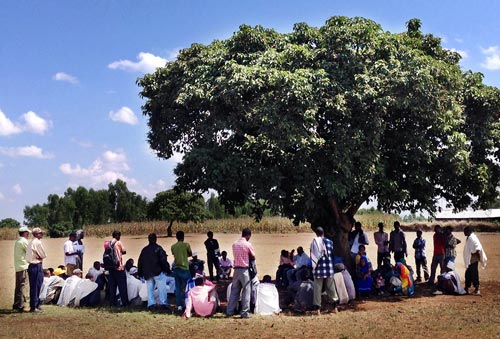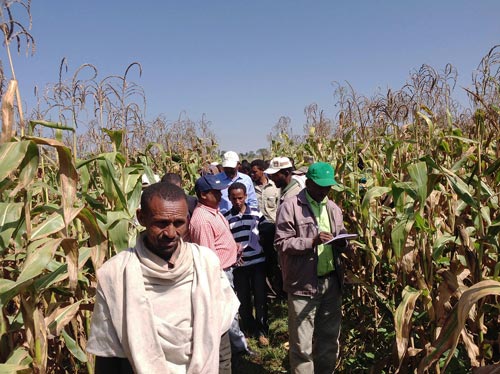By Moti Jaleta/CIMMYT

Farmers showcased the benefits of conservation agriculture in retaining soil moisture, reducing erosion and improving organic matter during field demonstrations in Ethiopia last week. The demonstrations were hosted by the Conservation Agriculture and Smallholder Farmers in Eastern and Southern Africa (CASFESA) project in Jabitehnan and South Achefer Districts.
The project, which is funded by the European Union International Fund for Agricultural Development, aims in part to show that conservation agriculture is sustainable and profitable, through demonstrations in randomly-selected villages in several African countries. Each conservation agriculture demonstration plot in 28 villages was visited by neighboring farmers in the last two months, raising awareness about the technology. The farmers’ field day and endof- season field evaluation were held during 9-10 November for farmers hosting conservation agriculture demonstrations, as well as extension and development agents in the demonstration villages and researchers from CIMMYT and the Amhara Regional Agricultural Research Institute. Other attending included delegates from the Amhara Region Bureau of Agriculture, Amhara Seed Enterprise, Merkeb Multipurpose Marketing Cooperative Union, the Jabitehnan and South Achefer District Office of Agriculture and the West Gojjam Zone Administration and Agriculture Office.

Farmers hosting demonstration plots said they saw conservation agriculture as a productivity-enhancing, labor-saving technology. Maize planted on conservation agriculture plots germinated three-to-four days earlier than that planted on conventional tillage plots. It was better anchored to the soil and resisted the wind without lodging. Intercropping cowpea with maize as a forage crop was introduced this season to reduce the pressure on the use of maize residue as livestock feed. Apart from its feed value, cowpea and maize intercropping suppressed weed germination and growth both on conventional and conservation agriculture plots.
Maize plants on both types of plots with cowpea intercropping were less dry than those on plots with only maize. Though farmers pledged to expand conservation agriculture technologies on their farms during the coming production season, they voiced concerns about the challenges of crop residue retention due to the local practice of free communal grazing on stubble after harvest. District and zonal administrators asked farmers to put community-based bylaws and enforcement mechanisms in place that restrict free grazing and livestock movements in farm plots after harvest. Participants brainstormed other solutions to facilitate the use of conservation agriculture in the region.
 Innovations
Innovations